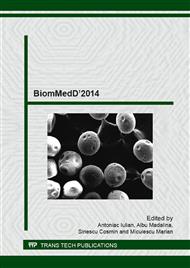p.3
p.8
p.14
p.20
p.27
p.31
p.38
p.47
Micro-Analytical Comparison on Elemental Composition of Nonstoichiometric Bovine Bone Derived Hydroxyapatite
Abstract:
Hydroxyapatite (HA) is one of the most common ceramic materials used for bone substitutions or reconstructions [1]. HA synthesis from natural sources is convenient relative to synthetic HA preparation while ensuring a similarity with viable bone tissue in terms of chemical composition and some other properties. One of the most important markers used for hydroxyapatite identification and differentiation from other calcium phosphates is the Ca/P ratio [2]. In order to perform a proper identification, this ratio should be evaluated with high accuracy, which involves a correct determination of the elemental concentrations. This study was made on a series of samples, derived from bovine osseous tissue, thermaly treated at 1000, 1100 and 1200°C. Establishing the influence of sample preparation on the Ca/P ratio assessment from the energy dispersion spectrometry (EDS) coupled with scanning electron microscopy determinations was intended. The samples were prepared by two completely different methods: mechanical fracture (without further preparation) and milling followed by homogenization. Regardless the sample preparation method, the analytical results represents the five measurements average performed on different spots.The EDS results showed that, within the same group, the compositional dissimilarities between the samples treated at different temperatures do not exceed 10% regardless of the sample preparation technique. For the same thermal treatment temperature, slight differences between the elemental chemical compositions of differently prepared samples were observed. The most important effect was a 20% decrease of the average Ca/P ratio for the samples prepared by milling and homogenization in regard to the mechanical fractured ones. Thereby, heat treated bovine bone samples’ milling and further homogenization for performing semi quantitative EDS analysis allows the Ca/P ratio assessment with a better accuracy.
Info:
Periodical:
Pages:
3-7
Citation:
Online since:
March 2015
Keywords:
Price:
Сopyright:
© 2015 Trans Tech Publications Ltd. All Rights Reserved
Share:
Citation:


